introduction
Ultra-relativistic heavy-ion collisions at the Large Hadron Collider (LHC) and Relativistic Heavy Ion Collider (RHIC) provide a unique arena for searching for a new form of nuclear matter, quark-gluon plasma (QGP), in which the degrees of freedom of the quarks and gluons in the protons and neutrons are released [1-5]. The strong interactions between the hard-scattered partons with the medium, referred to as the “jet quenching” phenomenon, open up new avenues to understand the properties of such a strongly-coupled quark matter [6-9] and test the fundamental theory of quantum chromodynamics (QCD) at the extremely hot and dense conditions [10-16]. In the past two decades, a series of tools have been extensively investigated to reveal this partonic strong interaction, such as the suppression factor RAA of high-pT hadron/jet [17-22], the momentum asymmetry of dijets [23-34], correlations of the vector boson associated jets (γ/Z0+jets) [35-40], the global event geometry [41, 42] and the jet substructures [43-52].
Because dijets are the dominant QCD processes in the hadron collisions in the experiment and are less influenced by the underlying background than inclusive jets, they exhibit a unique glamour in jet physics. The back-to-back configurations of the two leading jets in the transverse plane can significantly suppress the contribution of the underlying background of the jet reconstruction in both p+p and A+A collisions. In a vacuum, the parton shower effects and higher-order QCD processes may break the symmetry of the final-state dijets, leading to a deflection from the back-to-back azimuthal angle and an unequal transverse momentum between the leading and subleading jets. In A+A collisions, because the two jets usually experience asymmetric energy loss as traversing the QGP medium, the transverse momentum balance of dijets
Recently, the ATLAS Collaboration measured the dijet xJ in Xe+Xe collisions at
This paper presents the first theoretical study on medium modifications of the dijet pT–balance xJ in Xe+Xe collisions. The initial production of dijets was carried out using the POWHEG+PYTHIA8 prescription, which matches the next-to-leading-order (NLO) QCD matrix elements with the parton shower (PS) effect. The transport approach describes dijets’ in-medium evolution, which considers both elastic and inelastic partonic interactions in the quark-gluon plasma (QGP). First, we present the theoretical results of the dijet xJ in Xe+Xe collisions at
Theoretical framework
In this study, we generated next-to-leading-order (NLO) matrix elements for QCD jet processes [72] in the framework of POWHEG-BOX-V2 [73-75] and then simulated the parton shower (PS) with PYTHIA 8.309 [76] to produce p+p events. CT18NLO parton distribution functions (PDF) [77] were chosen for computation. The jets were reconstructed using the anti-kT clustering algorithm and the radius parameter R = 0.4, as implemented in the FastJet package [78]. Then, the two highest pT jets out of the set of jets in an event are selected as the dijet candidates. The leading jet transverse momentum pT,1 and subleading jet transverse momentum pT,2 must be greater than 100 GeV/c and 32 GeV/c, respectively. The two jets are required to be nearly back-to-back in azimuth with
We calculated the normalized xJ distributions in p+p collisions and compared them with the ATLAS data [55] as shown in Fig. 1. We observe that the xJ distributions calculated by POWHEG+PYTHIA8 provide decent descriptions at small value of xJ for all six different pT,1 intervals compared to the ATLAS data, except for a slight overestimation of xJ distributions compared to the ATLAS data near 1. At each pT interval, the xJ distribution peaks near
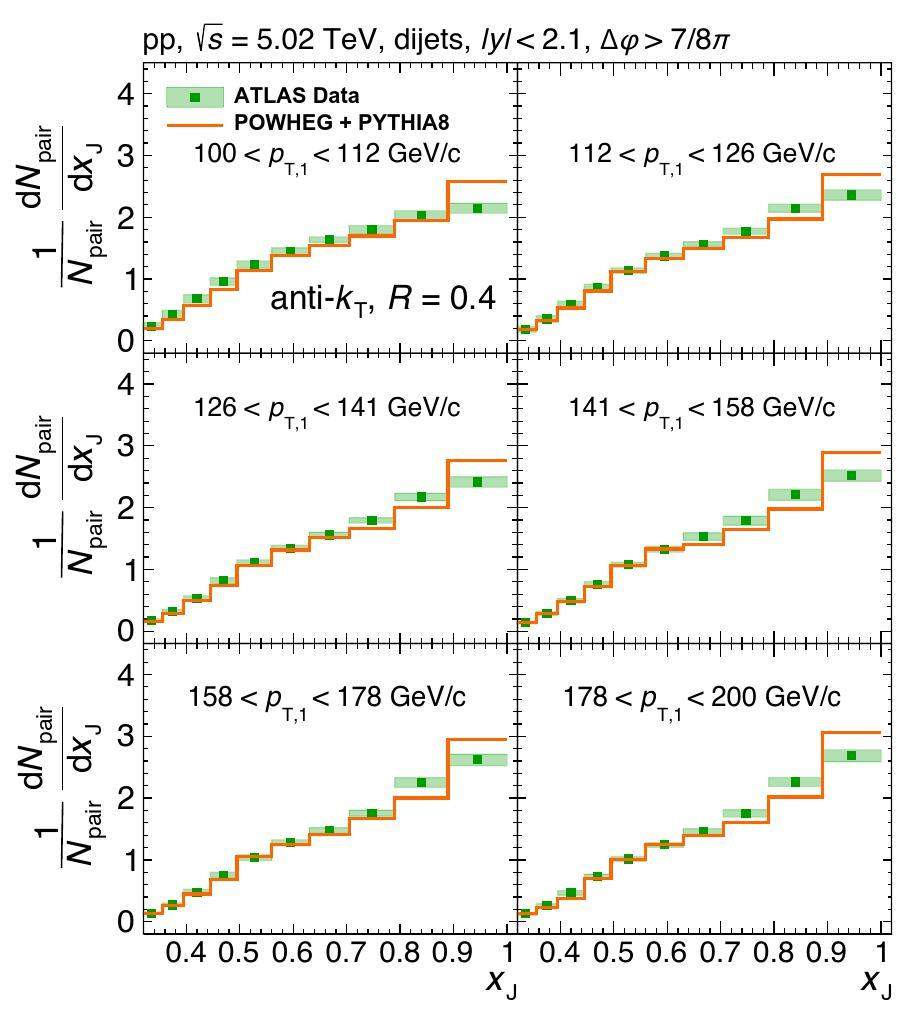
The in-medium evolution of both light- and heavy-flavor diets was simulated using the SHELL model [34, 79], which considers the elastic and inelastic partonic energy loss within the hot/dense QGP medium. The initial spatial distribution of hard scatterings was sampled using a Monte Carlo Glauber model [80]. Since the propagation of massive partons in the QCD medium can be viewed as “Brownian motion," the transport of heavy quarks can be well described by the modified Langevin equations,
For massless partons, the collisional energy loss is estimated by pQCD calculations within the Hard-Thermal Loop approximation [88, 89], whereas the same higher-twist formalism estimates their radiative contribution as for massive partons. The hydrodynamic time-space evolution of the QGP medium is described using CLVisc programs [90, 91], which provide the temperature and velocity of the expanding hot/dense nuclear matter. The SHELL model has been successfully applied in the study of heavy-flavor jets in high-energy nuclear collisions, which gives satisfactory descriptions on a series of experiment measurements, such as pT imbalance [34], radial profiles [79, 92-94] and fragmentation functions [95] of heavy-flavor jets, correlations of Z0+ HF hadron/jet [96, 97].
Numerical Results and Discussions
In Fig. 2a, we firstly show the dijet xJ distributions in Xe+Xe collisions at

| Pb+Pb | Xe+Xe | |||||
|---|---|---|---|---|---|---|
| bmin (fm) | bmax (fm) | bmin (fm) | bmax (fm) | |||
| 0%-10% | 0 | 4.98 | 3.52 | 0 | 4.28 | 3.02 |
| 10%-20% | 4.98 | 7.05 | 6.10 | 4.28 | 6.05 | 5.24 |
| 20%-40% | 7.05 | 9.98 | 8.64 | 6.05 | 8.56 | 7.41 |
| 40%-80% | 9.98 | 14.11 | 12.22 | 8.56 | 12.12 | 10.49 |
The flavor dependence of the medium modification of dijet pT balance is also an interesting topic in heavy ion collisions. Because of the different color factors, the gluon-initiated jets are expected to lose more energy than the quark-initiated one as traversing the hot and dense nuclear matter, and the “dead-cone” effect also leads to smaller energy loss of heavy quarks than that of the light one [2, 18, 65-68]. An optimal step toward this goal is determining the flavor of the selected jets in nucleus-nucleus collisions using an infrared and collinear (IRC) safe jet algorithm. In recent years, four IRC-safe jet-algorithm-based approaches have been developed to identify the flavor of the underlying hard partons for the final-state reconstructed jets, called “flavor-kT” [98], “flavor anti-kT” [99], “flavor-dressing” [100] and “Interleaved Flavor Neutralisation (IFN)” [101]. In this study, we employ the IFN algorithm to identify the flavor of the reconstructed jets at the parton level for gluon jets, light-quark jets, and heavy-flavor jets in both p+p and nucleus-nucleus collisions. Because the flavor information of the jets is accessible at each stage of the clustering sequence, the IFN algorithm provides consistent flavor identification for both the full jets and their substructures. It should be noted that identifying gluon and quark jets in experiments remains challenging, although such identification can be achieved through Monte Carlo simulations based on the complete flavor information of the jet particles. Note that the IFN algorithm is applicable to all jets at the parton level but is currently only accessible for heavy-flavor jets at the hadron level. As the first theoretical exploration, in the present work, we identified the jet flavor at the parton level; hence, flavor identification of both inclusive dijets and heavy-flavor dijets could be efficiently implemented.
Using the IFN algorithm, inclusive dijet events can be classified into three categories: gluon-gluon (gg), quark-gluon (qg), and quark-quark (qq). In particular, by distinguishing the flavor of the leading jet, qg dijets can be further divided into q1g2 and g1q2, denoting the quark-jet-leading and gluon-jet-leading quark-gluon dijets, respectively. In the left column of Fig. 3, we show the normalized xJ distributions of gg, qg, qq, and inclusive dijets in both p+p and 0%-10% Xe+Xe collisions at
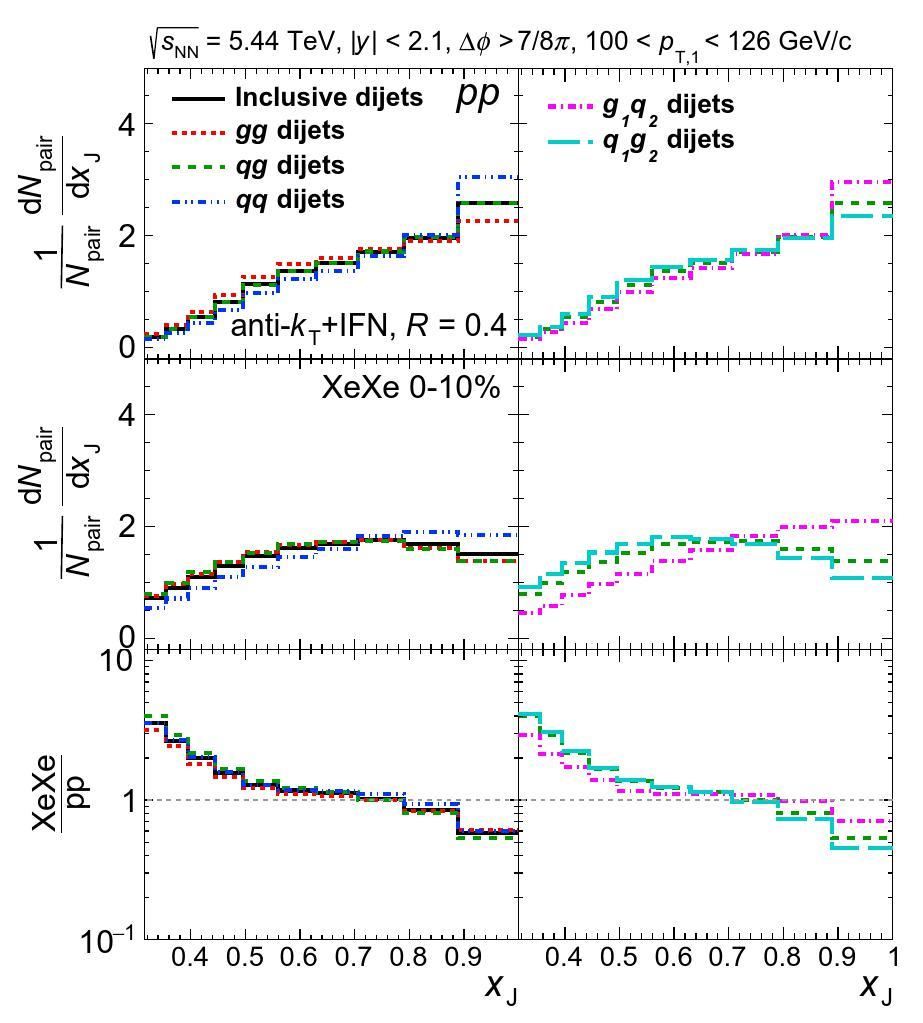
We also estimated the component fractions of the dijet sample in p+p and 0%-10% Xe+Xe collisions at
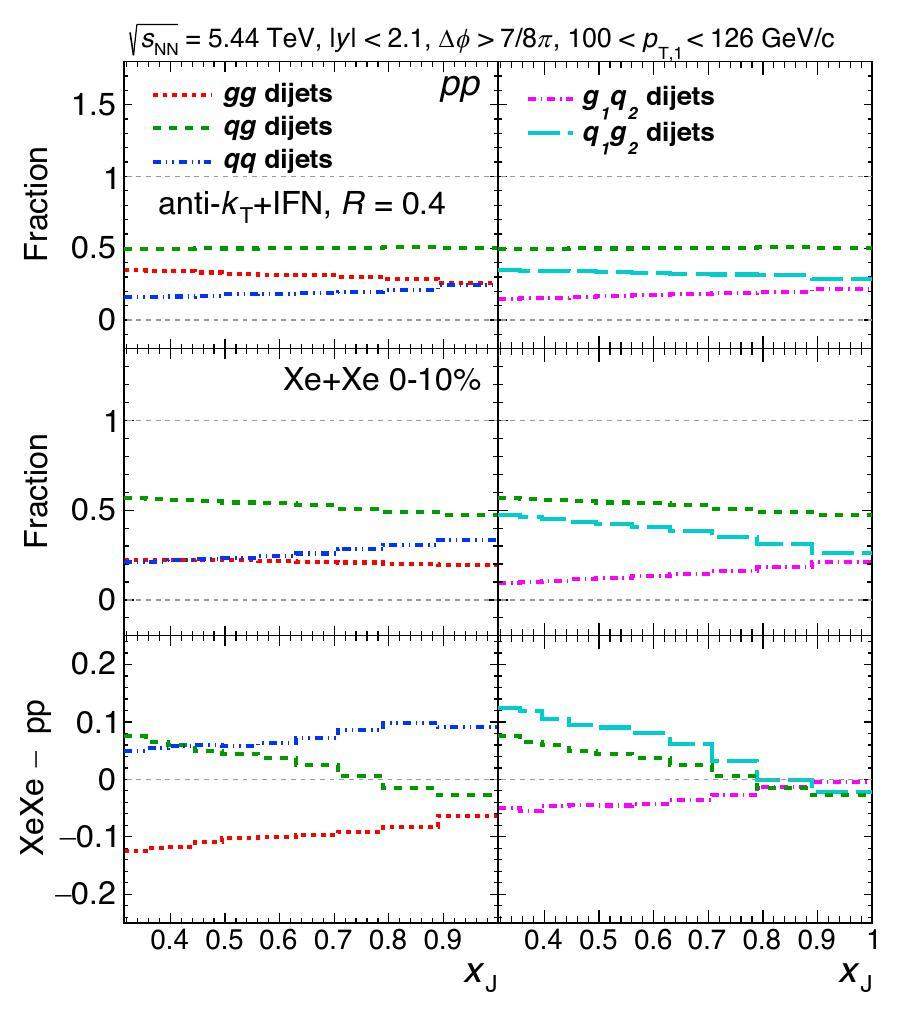
To quantify the overall shift in the xJ distribution in Xe+Xe collisions relative to p+p, we calculated the average values (
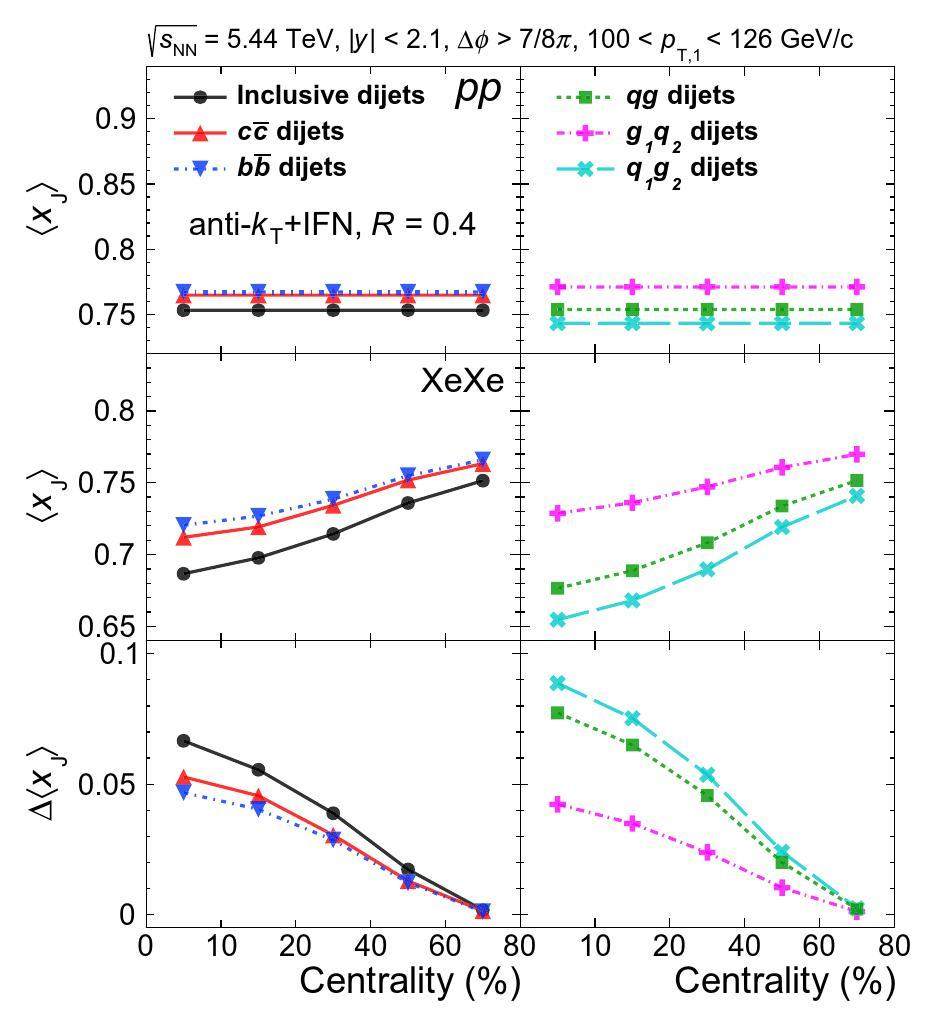
To quantitatively characterize the relative dijet yield suppression between the Xe+Xe and Pb+Pb collisions, the nuclear modification factors for the leading jets, ρXe,Pb(pT,1), are defined as follows (similarly, ρXe,Pb(pT,2) can be defined for subleading jets):
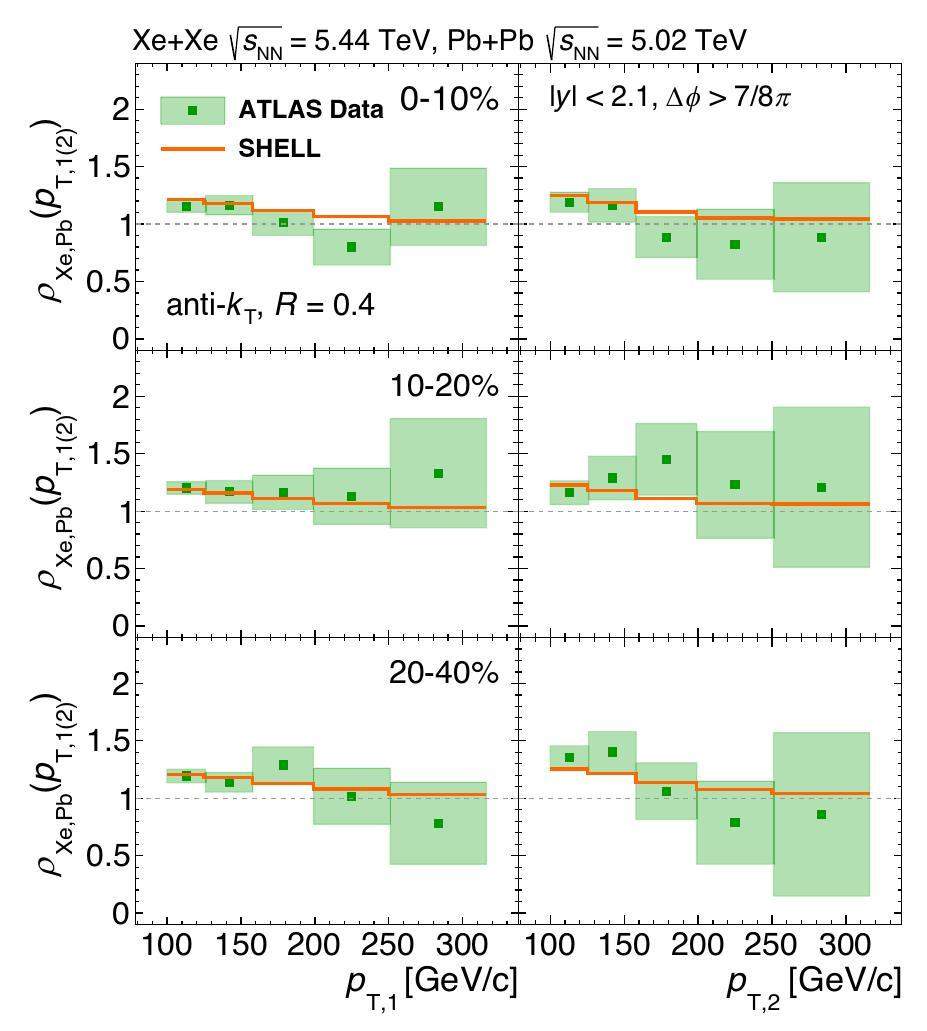
Conclusion
In this paper, we present the first investigation of the medium modifications of dijet pT balance (xJ) in Xe+Xe collisions at
Gluon shadowing and jet quenching in A+A collisions at s = 200 AGeV
. Phys. Rev. Lett. 68, 1480-1483 (1992). https://doi.org/10.1103/PhysRevLett.68.1480Jet quenching and radiative energy loss in dense nuclear matter
. Quark-Gluon Plasma 3, 123 (2004). https://doi.org/10.1142/9789812795533_0003Jet physics in heavy-ion collisions
. Int. J. Mod. Phys. A 28, 1340013 (2013). https://doi.org/10.1142/S0217751X13400137Jet quenching in high-energy heavy-ion collisions
. Int. J. Mod. Phys. E 24, no. 11, 1530014 (2015). https://doi.org/10.1142/S0218301315300143, https://doi.org/10.1142/9789814663717_0007Parton energy loss with detailed balance
. Phys. Rev. Lett. 87, 142301 (2001). https://doi.org/10.1103/PhysRevLett.87.142301Extracting the jet transport coefficient from jet quenching in high-energy heavy-ion collisions
. Phys. Rev. C 90, 014909 (2014). https://doi.org/10.1103/PhysRevC.90.014909Information-field-based global Bayesian inference of the jet transport coefficient
. Phys. Rev. C 108, L011901 (2023). https://doi.org/10.1103/PhysRevC.108.L011901Phenomenological study of the anisotropic quark matter in the two-flavor Nambu–Jona–Lasinio model
. Nucl. Sci. Tech. 33, 150 (2022). https://doi.org/10.1007/s41365-022-01129-4Multisystem Bayesian constraints on the transport coefficients of QCD matter
. Phys. Rev. C 103, 054904 (2021). https://doi.org/10.1103/PhysRevC.103.054904Studying the QGP with Jets at the LHC and RHIC
. Prog. Part. Nucl. Phys. 124, 103940 (2022). https://doi.org/10.1016/j.ppnp.2022.103940Jet quenching and medium response in high-energy heavy-ion collisions: a review
. Rept. Prog. Phys. 84, 024301 (2021). https://doi.org/10.1088/1361-6633/abc22bSuperdense Matter: Neutrons Or Asymptotically Free Quarks
?. Phys. Rev. Lett. 34, 1353 (1975). https://doi.org/10.1103/PhysRevLett.34.1353An experimental review of open heavy flavor and quarkonium production at RHIC
. Nucl. Sci. Tech. 31, 81 (2020). https://doi.org/10.1007/s41365-020-00785-8Recent development of hydrodynamic modeling in heavy-ion collisions
. Nucl. Sci. Tech. 31, 122 (2020). https://doi.org/10.1007/s41365-020-00829-zDensity fluctuations in intermediate-energy heavy-ion collisions
. Nucl. Sci. Tech. 33, 52 (2022). https://doi.org/10.1007/s41365-022-01040-yRecent developments in chiral and spin polarization effects in heavy-ion collisions
. Nucl. Sci. Tech. 31, 90 (2020). https://doi.org/10.1007/s41365-020-00801-xMeasurements of the Nuclear Modification Factor for Jets in Pb+Pb Collisions at sNN=2.76 TeV with the ATLAS Detector
. Phys. Rev. Lett. 114, 072302 (2015). https://doi.org/10.1103/PhysRevLett.114.072302Effect of jet quenching on high pT hadron spectra in high-energy nuclear collisions
. Phys. Rev. C 58, 2321 (1998). https://doi.org/10.1103/PhysRevC.58.2321Systematic Comparison of Jet Energy-Loss Schemes in a realistic hydrodynamic medium
. Phys. Rev. C 79, 024901 (2009). https://doi.org/10.1103/PhysRevC.79.024901Jet tomography of dense and nuclear matter
. Phys. Rev. Lett. 89, 162301 (2002). https://doi.org/10.1103/PhysRevLett.89.162301Determining the jet transport coefficient q^ from inclusive hadron suppression measurements using Bayesian parameter estimation
. Phys. Rev. C 104, 024905 (2021). https://doi.org/10.1103/PhysRevC.104.024905Interplaying mechanisms behind single inclusive jet suppression in heavy-ion collisions
. Phys. Rev. C 99, 054911 (2019). https://doi.org/10.1103/PhysRevC.99.054911Observation of a Centrality-Dependent Dijet Asymmetry in Lead-Lead Collisions at sNN=2.77 TeV with the ATLAS Detector at the LHC
. Phys. Rev. Lett. 105, 252303 (2010). https://doi.org/10.1103/PhysRevLett.105.252303Dihadron tomography of high-energy nuclear collisions in NLO pQCD
. Phys. Rev. Lett. 98, 212301 (2007). https://doi.org/10.1103/PhysRevLett.98.212301Explanation of Di-jet asymmetry in Pb+Pb collisions at the Large Hadron Collider
. Phys. Rev. Lett. 106, 162302 (2011) [erratum: Phys. Rev. Lett. 108, 189904 (2012)]. https://doi.org/10.1103/PhysRevLett.106.162302Influence of multiple in-medium scattering processes on the momentum imbalance of reconstructed di-jets
. J. Phys. G 42, 115104 (2015). https://doi.org/10.1088/0954-3899/42/11/115104Light and heavy flavor dijet production and dijet mass modification in heavy ion collisions
. Phys. Rev. D 99, 034006 (2019). https://doi.org/10.1103/PhysRevD.99.034006Observation and studies of jet quenching in PbPb collisions at nucleon-nucleon center-of-mass energy = 2.76 TeV
. Phys. Rev. C 84, 024906 (2011). https://doi.org/10.1103/PhysRevC.84.024906Transverse momentum imbalance of back-to-back particle production in p+A and e+A collisions
. Phys. Rev. D 86, 094010 (2012). https://doi.org/10.1103/PhysRevD.86.094010Dihadron momentum imbalance and correlations in d+Au collisions
. Phys. Rev. D 85, 054024 (2012). https://doi.org/10.1103/PhysRevD.85.054024Overall momentum balance and redistribution of the lost energy in asymmetric dijet events in 2.76A TeV Pb-Pb collisions with a multiphase transport model
. Phys. Rev. C 97, 044903 (2018). https://doi.org/10.1103/PhysRevC.97.044903Energy dependence of the dijet imbalance in Pb-Pb collisions at 2.76 ATeV
. Phys. Rev. C 86, 061901 (2012). https://doi.org/10.1103/PhysRevC.86.061901Dijet Asymmetry in the Resummation Improved Perturbative QCD Approach
. Phys. Lett. B 782, 773-778 (2018). https://doi.org/10.1016/j.physletb.2018.06.002Transverse Momentum Balance and Angular Distribution of bb¯ Dijets in Pb+Pb collisions
. Chin. Phys. C 44, 104105 (2020). https://doi.org/10.1088/1674-1137/abab8fStudies of Jet Quenching using Isolated-Photon + Jet Correlations in PbPb and pp Collisions at sNN=2.76 TeV
. Phys. Lett. B 718, 773-794 (2013). https://doi.org/10.1016/j.physletb.2012.11.003The Physics of Z0/γ*-tagged jets at the LHC
. Phys. Rev. C 83, 034902 (2011). https://doi.org/10.1103/PhysRevC.83.034902Momentum imbalance of isolated photon-tagged jet production at RHIC and LHC
. Phys. Rev. Lett. 110, 142001 (2013). https://doi.org/10.1103/PhysRevLett.110.142001Photon-tagged and B-meson-tagged b-jet production at the LHC
. Phys. Lett. B 750, 287-293 (2015). https://doi.org/10.1016/j.physletb.2015.09.0293D Structure of Jet-Induced Diffusion Wake in an Expanding Quark-Gluon Plasma
. Phys. Rev. Lett. 130, 052301 (2023). https://doi.org/10.1103/PhysRevLett.130.052301Medium modification of γ-jet fragmentation functions in Pb+Pb collisions at LHC
. Phys. Lett. B 810, 135783 (2020). https://doi.org/10.1016/j.physletb.2020.135783The global geometrical property of jet events in high-energy nuclear collisions
. Eur. Phys. J. C 80, 865 (2020). https://doi.org/10.1140/epjc/s10052-020-08452-3Multijet topology in high-energy nuclear collisions: jet broadening
. https://arxiv.org/abs/2304.04649arXiv:2304.04649Modification of Jet Shapes in PbPb Collisions at sNN=2.76 TeV
. Phys. Lett. B 730, 243-263 (2014). https://doi.org/10.1016/j.physletb.2014.01.042Jet tomography of high-energy nucleus-nucleus collisions at next-to-leading order
. Phys. Rev. Lett. 104, 132001 (2010). https://doi.org/10.1103/PhysRevLett.104.132001A Theory of jet shapes and cross-sections: From hadrons to nuclei
. JHEP 0811, 093 (2008). https://doi.org/10.1088/1126-6708/2008/11/093Parton splitting scales of reclustered large-radius jets in high-energy nuclear collisions
. Eur. Phys. J. C 82, 414 (2022). https://doi.org/10.1140/epjc/s10052-022-10340-xpT dispersion of inclusive jets in high-energy nuclear collisions
. Chin. Phys. C 46, 104102 (2022). https://doi.org/10.1088/1674-1137/ac79aaZ+jet correlation with NLO-matched parton-shower and jet-medium interaction in high-energy nuclear collisions
. Phys. Rev. C 98, 021901 (2018). https://doi.org/10.1103/PhysRevC.98.021901Heavy-Flavor Jets in High-Energy Nuclear Collisions
. Symmetry 15, 727 (2023). https://doi.org/10.3390/sym15030727Hard Jet Substructure in a Multi-stage Approach
. https://arxiv.org/abs/2301.02485arXiv:2301.02485Jet Radius and Momentum Splitting Fraction with Dynamical Grooming in Heavy-Ion Collisions
. Chin. Phys. Lett. 40, 032101 (2023). https://doi.org/10.1088/0256-307X/40/3/032101Phenomenological study of the angle between jet axes in heavy-ion collisions
. https://arxiv.org/abs/2312.15518arXiv:2312.15518Measurement of jet pT correlations in Pb+Pb and pp collisions at sNN= 2.76 TeV with the ATLAS detector
. Phys. Lett. B 774, 379-402 (2017). https://doi.org/10.1016/j.physletb.2017.09.078Origins of the di-jet asymmetry in heavy ion collisions
. Eur. Phys. J. C 76, 288 (2016). https://doi.org/10.1140/epjc/s10052-016-4130-9Measurements of the suppression and correlations of dijets in Pb+Pb collisions at sNN=5.02 TeV
. Phys. Rev. C 107, 054908 (2023). https://doi.org/10.1103/PhysRevC.107.054908Jet Momentum Dependence of Jet Quenching in PbPb Collisions at sNN=2.76 TeV
. Phys. Lett. B 712, 176-197 (2012). https://doi.org/10.1016/j.physletb.2012.04.058Comparing transverse momentum balance of b jet pairs in pp and PbPb collisions at sNN=5.02 TeV
. JHEP 03, 181 (2018). https://doi.org/10.1007/JHEP03(2018)181Dijet imbalance measurements in Au+Au and pp collisions at sNN=200 GeV at STAR
. Phys. Rev. Lett. 119, 062301 (2017). https://doi.org/10.1103/PhysRevLett.119.062301Measurements of the suppression and correlations of dijets in Xe+Xe collisions at sNN=5.44 TeV
. Phys. Rev. C 108, 024906 (2023). https://doi.org/10.1103/PhysRevC.108.024906Transverse momentum spectra and nuclear modification factors of charged particles in Xe-Xe collisions at sNN = 5.44 TeV
. Phys. Lett. B 788, 166-179 (2019). https://doi.org/10.1016/j.physletb.2018.10.052Measurement of the azimuthal anisotropy of charged-particle production in Xe+Xe collisions at sNN=5.44 TeV with the ATLAS detector
. Phys. Rev. C 101, 024906 (2020). https://doi.org/10.1103/PhysRevC.101.024906Extracting jet transport coefficient via single hadron and dihadron productions in high-energy heavy-ion collisions
. Eur. Phys. J. C 79, 589 (2019). https://doi.org/10.1140/epjc/s10052-019-7100-1Scaling behaviors of heavy flavor meson suppression and flow in different nuclear collision systems at the LHC
. Eur. Phys. J. C 81, 1035 (2021). https://doi.org/10.1140/epjc/s10052-021-09833-yParticle production at large pT in Xe+Xe collisions with jet quenching using the higher twist approach
. Chin. Phys. C 46, 104106 (2022). https://doi.org/10.1088/1674-1137/ac7b75Heavy quark colorimetry of QCD matter
. Phys. Lett. B 519, 199-206 (2001). https://doi.org/10.1016/S0370-2693(01)01130-3Heavy quark energy loss in nuclear medium
. Phys. Rev. Lett. 93, 072301 (2004). https://doi.org/10.1103/PhysRevLett.93.072301Medium induced gluon radiation off massive quarks fills the dead cone
. Phys. Rev. D 69, 114003 (2004). https://doi.org/10.1103/PhysRevD.69.114003Where is the charm quark energy loss at RHIC
?. Phys. Lett. B 560, 37-43 (2003). https://doi.org/10.1016/S0370-2693(03)00327-7Flavor hierarchy of jet quenching in relativistic heavy-ion collisions
. Phys. Lett. B 805, 135424 (2020). https://doi.org/10.1016/j.physletb.2020.135424Flavor hierarchy of parton energy loss in quark-gluon plasma from a Bayesian analysis
. Phys. Lett. B 850, 138523 (2024). https://doi.org/10.1016/j.physletb.2024.138523Flavor dependence of jet quenching in heavy-ion collisions
. Phys. Lett. B 850, 138549 (2024). https://doi.org/10.1016/j.physletb.2024.138549Jet pair production in POWHEG
. JHEP 04, 081 (2011). https://doi.org/10.1007/JHEP04(2011)081A New method for combining NLO QCD with shower Monte Carlo algorithms
. JHEP 11, 040 (2004). https://doi.org/10.1088/1126-6708/2004/11/040Matching NLO QCD computations with Parton Shower simulations: the POWHEG method
. JHEP 11, 070 (2007). https://doi.org/10.1088/1126-6708/2007/11/070A general framework for implementing NLO calculations in shower Monte Carlo programs: the POWHEG BOX
. JHEP 06, 043 (2010). https://doi.org/10.1007/JHEP06(2010)043A comprehensive guide to the physics and usage of PYTHIA 8.3
. SciPost Phys. Codeb. 2022, 8 (2022). https://doi.org/10.21468/SciPostPhysCodeb.8Progress in the CTEQ-TEA NNLO global QCD analysis
. https://arxiv.org/abs/1908.11394arXiv:1908.11394FastJet User Manual
. Eur. Phys. J. C 72, 1896 (2012). https://doi.org/10.1140/epjc/s10052-012-1896-2Radial profile of bottom quarks in jets in high-energy nuclear collisions
. Chin. Phys. C 45, 064105 (2021). https://doi.org/10.1088/1674-1137/abf4f5Glauber modeling in high energy nuclear collisions
. Ann. Rev. Nucl. Part. Sci. 57, 205-243 (2007). https://doi.org/10.1146/annurev.nucl.57.090506.123020Multiple scattering, parton energy loss and modified fragmentation functions in deeply inelastic e A scattering
. Phys. Rev. Lett. 85, 3591-3594 (2000). https://doi.org/10.1103/PhysRevLett.85.3591Multiple parton scattering in nuclei: Beyond helicity amplitude approximation
. Nucl. Phys. A 720, 429 (2003). https://doi.org/10.1016/S0375-9474(03)01003-0Hard collinear gluon radiation and multiple scattering in a medium
. Phys. Rev. D 85, 014023 (2012). https://doi.org/10.1103/PhysRevD.85.014023Multiple Parton Scattering in Nuclei: Modified DGLAP Evolution for Fragmentation Functions
. Phys. Rev. C 81, 024902 (2010). https://doi.org/10.1103/PhysRevC.81.024902Bulk matter evolution and extraction of jet transport parameter in heavy-ion collisions at RHIC
. Phys. Rev. C 81, 064908 (2010). https://doi.org/10.1103/PhysRevC.81.064908Measurement of electrons from semileptonic heavy-flavor hadron decays at midrapidity in pp and Pb-Pb collisions at sNN = 5.02 TeV
. Phys. Lett. B 804, 135377 (2020). https://doi.org/10.1016/j.physletb.2020.135377Open Heavy-Flavor Production in Heavy-Ion Collisions
. Ann. Rev. Nucl. Part. Sci. 69, 417-445 (2019). https://doi.org/10.1146/annurev-nucl-101918-023806Thermal field theory derivation of the source term induced by a fast parton from the quark energy-momentum tensor
. Phys. Rev. D 83, 065012, (2011). https://doi.org/10.1103/PhysRevD.83.065012Inclusive b-jet production in heavy ion collisions at the LHC
. Phys. Lett. B 726, 251-256 (2013). https://doi.org/10.1016/j.physletb.2013.08.009Vortical Fluid and Λ Spin Correlations in High-Energy Heavy-Ion Collisions
. Phys. Rev. Lett. 117, 192301 (2016). https://doi.org/10.1103/PhysRevLett.117.192301Pseudorapidity distribution and decorrelation of anisotropic flow within the open-computing-language implementation CLVisc hydrodynamics
. Phys. Rev. C 97, 064918 (2018). https://doi.org/10.1103/PhysRevC.97.064918Radial distribution of charm quarks in jets in high-energy heavy-ion collisions
. Nucl. Phys. A 1005, 121787 (2021). https://doi.org/10.1016/j.nuclphysa.2020.121787Diffusion of charm quarks in jets in high-energy heavy-ion collisions
. Eur. Phys. J. C 79, 789 (2019). https://doi.org/10.1140/epjc/s10052-019-7312-4Radial profile of heavy quarks in jets in high-energy nuclear collisions
. PoS HardProbes2020, 097 (2021). https://doi.org/10.22323/1.387.0097Longitudinal momentum fraction of heavy-flavor mesons in jets in high-energy nuclear collisions
. Phys. Rev. C 108, 2 (2023). https://doi.org/10.1103/PhysRevC.108.024905Z0 boson associated b-jet production in high-energy nuclear collisions
. Chin. Phys. C 47, 054102 (2023). https://doi.org/10.1088/1674-1137/acc1caProbing the in-medium PT-broadening by γ +HF angular de-correlations
. Eur. Phys. J. A 58, 135 (2022). https://doi.org/10.1140/epja/s10050-022-00785-9Infrared safe definition of jet flavor
. Eur. Phys. J. C 47, 113-124 (2006). https://doi.org/10.1140/epjc/s2006-02552-4Infrared-safe flavoured anti-kT jets
. JHEP 04, 138 (2023). https://doi.org/10.1007/JHEP04(2023)138Flavor Identification of Reconstructed Hadronic Jets
. Phys. Rev. Lett. 130, 161901 (2023). https://doi.org/10.1103/PhysRevLett.130.161901Flavored jets with exact anti-kt kinematics and tests of infrared and collinear safety
. Phys. Rev. D 108, 094010 (2023). https://doi.org/10.1103/PhysRevD.108.094010PYTHIA 6.4 Physics and Manual
. JHEP 05, 026 (2006). https://doi.org/10.1088/1126-6708/2006/05/026Production of the heavy-flavor decay lepton in high-energy nuclear collisions
. https://arxiv.org/abs/2308.14538arXiv:2308.14538The authors declare that they have no competing interests.


